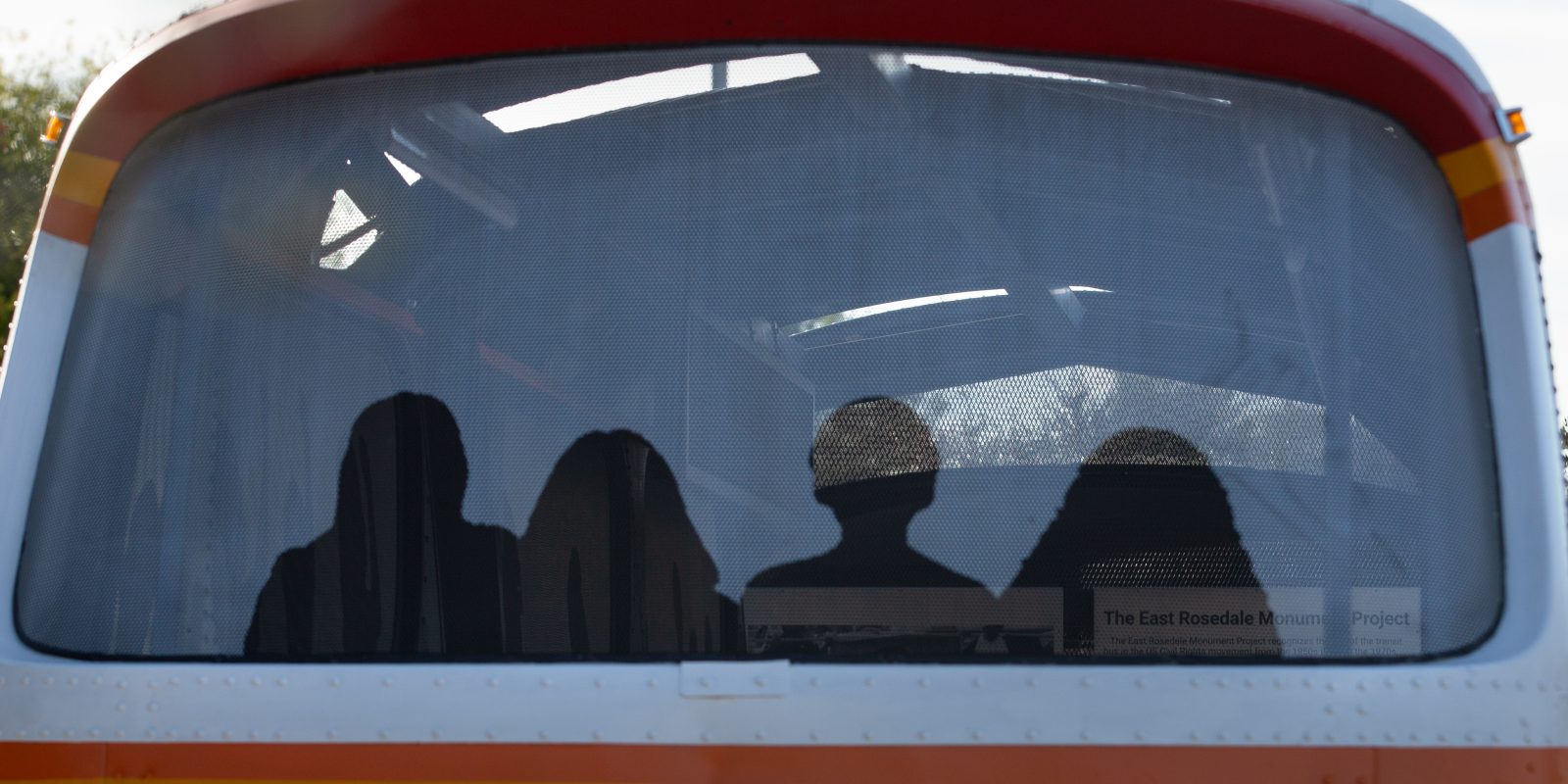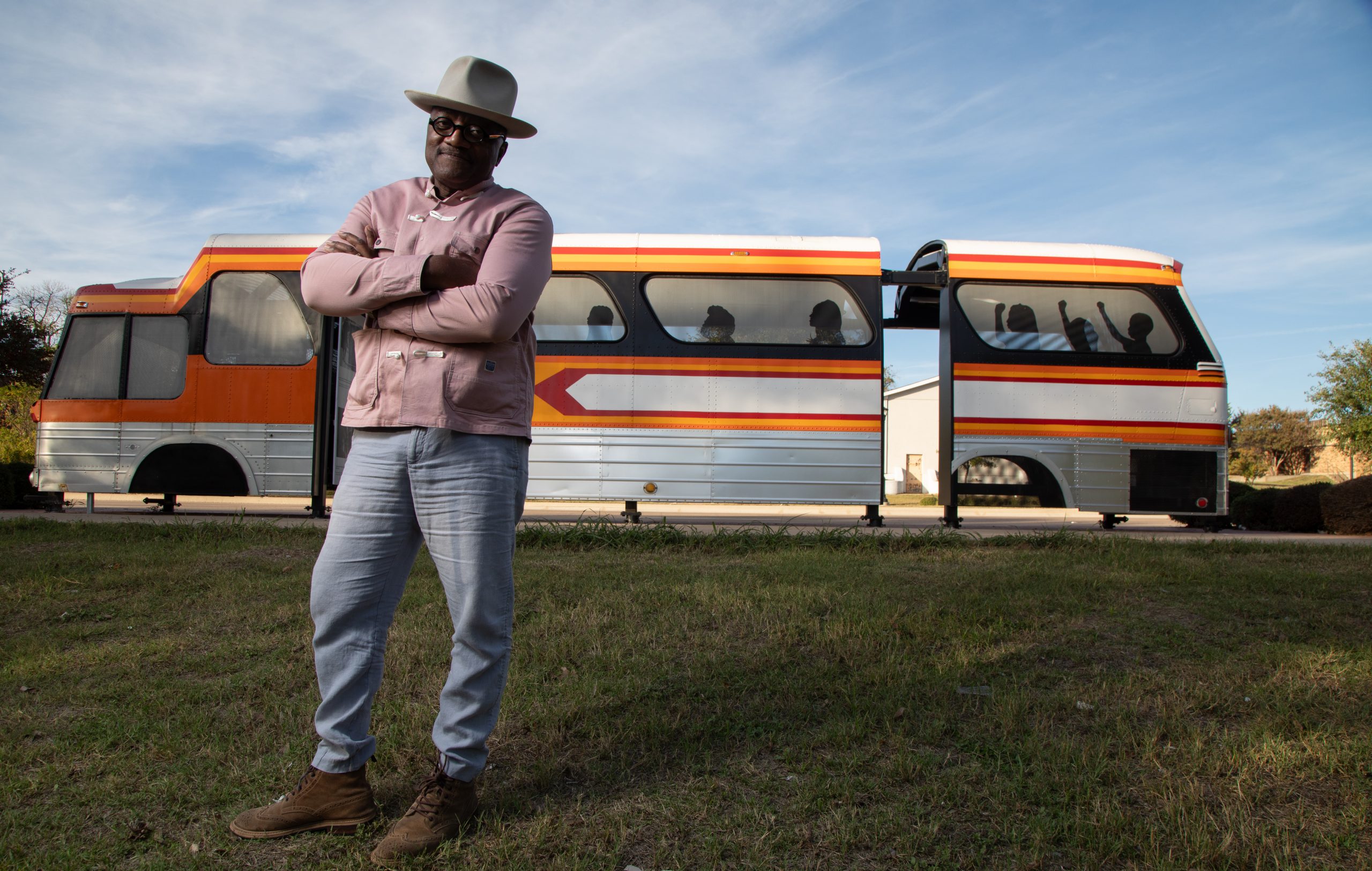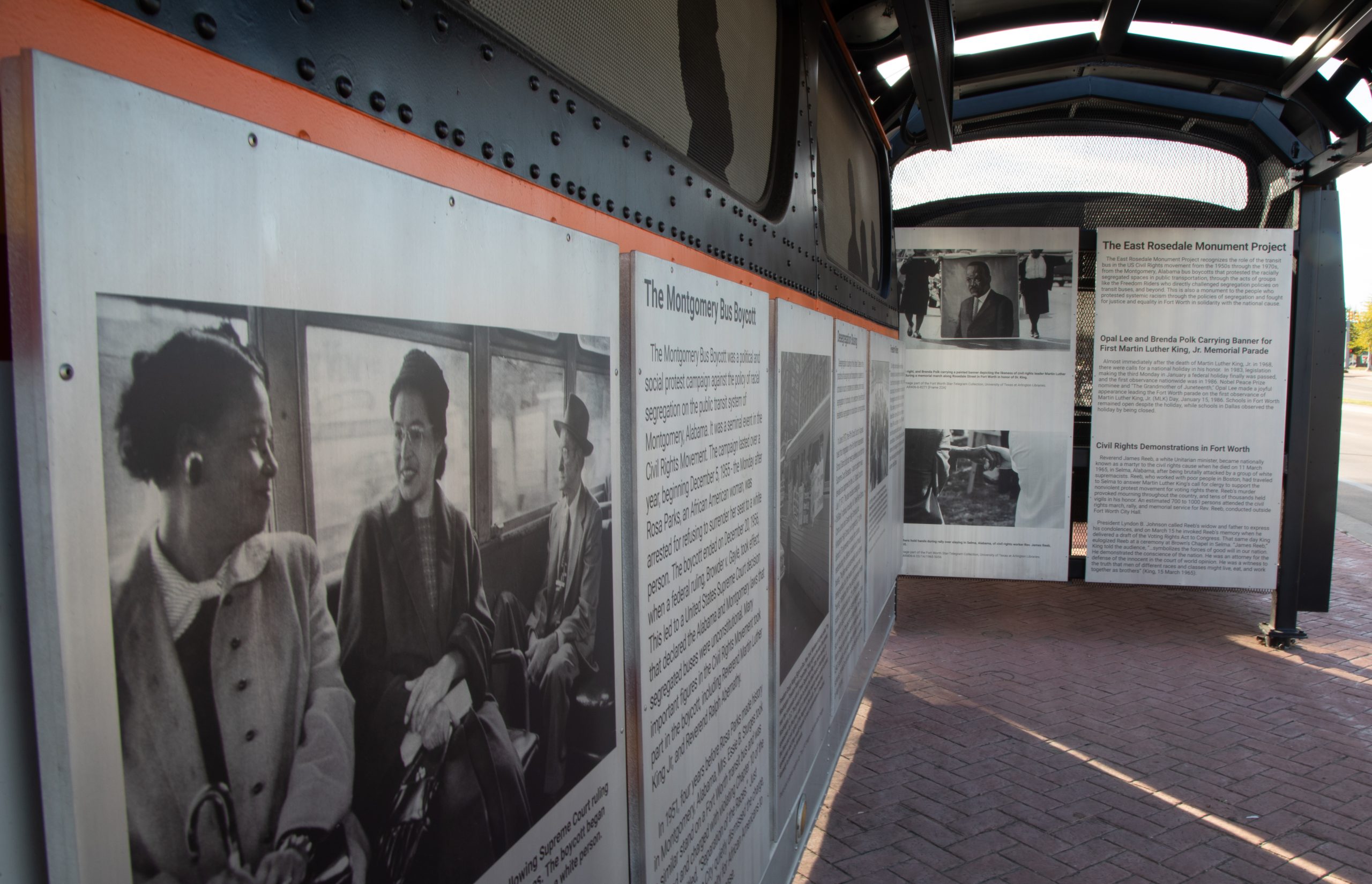
Artist and writer Christopher Blay created the East Rosedale Monument Project, inspired by the role of transit buses in the Civil Rights Movement.
Impact Through Art
Creator and curator Christopher Blay’s work centers on the Black experience.
What looks at first glance like a deconstructed city bus sits on the 900 block of Fort Worth’s East Rosedale Street, steps away from the future home of the National Juneteenth Museum. For Christopher Blay ’03, this spot four miles northeast of TCU’s main campus represents the pinnacle of his professional journey as an artist, thinker and leader. In addition to being the artist behind the city bus installation, Blay joined the National Juneteenth Museum in September as director of public programs.
In 2014, the Fort Worth Public Art Commission invited Blay to submit a proposal for what would become the East Rosedale Monument Project. Inspired by the role of transit buses in the Civil Rights Movement, the sculptor, painter and photographer drew up designs that he hoped would resonate with Fort Worth’s residents, particularly those living in the Historic Southside/Hillside neighborhoods surrounding East Rosedale.
The Covid-19 pandemic slowed the project’s progress, which saw a ’70s-era bus transported from Texas to a fabricator in Indianapolis to execute Blay’s vision. In June, he traveled from Houston to help oversee the installation of the bus in its permanent home in Fort Worth.
Blay put his background as a photojournalist and arts writer to use in 10 large, engraved panels fixed to the bus’s interior. Through images and text, he highlighted a range of key players and events in the struggle for racial equality including Opal Lee, the “grandmother of Juneteenth,” as well as the Montgomery Bus Boycott and local civil rights demonstrations in March 1968. The artist also created silhouettes of area children to adorn the windows, taking their place as bus riders.

Christopher Blay’s East Rosedale Monument Project was a decade-long endeavor culminating in a dedication event at nearby Ella Mae Shamblee Library.
“To me, knowledge is power, and what Christopher has done that’s so valuable is to tell the story of how the bus was such an intricate piece of life for so many people,” said Estella Williams, president of the Fort Worth/Tarrant County chapter of the NAACP. “He did the research, talked to people who live here and came up with something that’s visionary and meaningful.”
Blay’s personal history shapes his work, too. A native of Liberia who grew up about a mile and a half from the West African coastline, Blay moved to Irving, Texas, while on the cusp of adulthood. After earning an associate’s degree at Tarrant County College, he transferred to TCU in 2000.
As a Horned Frog his focus included photography and sculpture. Studio art classes heightened his awareness of different materials; for his senior show, he created a series of photographs mounted inside wooden boxes that he built, lined with silk and topped with a velvet curtain. The viewer had to lift the curtain to peer at the image.
“It was about understanding there’s a separation between the photographer and the subject,” he said.
On the Move
Armed with a bachelor’s degree, Blay worked for a short stint as a security guard at the Kimbell Art Museum before joining the staff of the Fort Worth Star-Telegram in 2005 as an assistant photo editor. He spent three years on the evening shift, assigning stories to photographers and sometimes grabbing a camera to cover newsworthy events himself.
When the economic crisis of 2008 forced mass layoffs at the newspaper, Blay pivoted to become the curator of the art corridor galleries at Tarrant County College Southeast in nearby Arlington.
“The photo editor job had to do with facts, assignments and telling very specific stories,” he said. “My work as a curator at the art corridor gallery was about engaging with artists and ideas, some of them philosophical, some of them personal, some of them conceptual.”
He devoted a decade of his professional life to filling three on-campus spaces with student exhibitions, faculty exhibitions and the work of regional artists. Blay planned the exhibitions about a year in advance and did everything from designing the exhibition posters to installing the artwork to writing news releases.
All the while, he continued to make his own art, including public art projects in Dallas, with two non-permanent pieces funded by the National Endowment for the Arts for the Tenth Street Historic District.
In 2019, Blay relocated to Houston to take over as news editor at Glasstire, an online magazine devoted to the visual arts in Texas. At his home in Texas’s most populous city, he continued to produce sculpture, painting and photography that spoke about the Black experience.
“The things that happened pre-George Floyd are still happening. I think artists will always respond to injustice, and museums have an obligation to give artists space to say the things they are there to say. There’s no point to a museum if it isn’t a space where you can have conversations.”
Christopher Blay
“People have been making beautiful things simply to make beautiful things since the first cave person grabbed the burnt stick and made a mark,” Blay said. “But even in that same first gesture is considering the world and considering ideas, and that is the arena I am most drawn to.”
In 2021, he became a contributing writer for Art in America, a quarterly national arts magazine, and he accepted a position as the chief curator for the Houston Museum of African American Culture. He planned exhibitions, maintained the museum’s social media presence and networked with artists at a time when racial politics had risen to the top of the national consciousness.
“The things that happened pre-George Floyd are still happening,” Blay said. “I think artists will always respond to injustice, and museums have an obligation to give artists space to say the things they are there to say. There’s no point to a museum if it isn’t a space where you can have conversations.”
Driving Discussions
Through the East Rosedale Monument Project, which was funded by public bonds, Blay hopes to spark curiosity about the city’s past. Alida Labbe, public art project and capital budget manager for Arts Fort Worth, helped shepherd the 37-foot-long sculpture from concept to reality.
“We’re decades removed from desegregation and busing in Fort Worth so it’s really meaningful to cement those stories in history,” she said. “The way he manipulated the bus so there aren’t any doors is a way to invite people in to learn these stories through photographs and text.”
The proximity to the future home of the National Juneteenth Museum — a 50,000-square-foot building slated to open in late 2026 — feels more than serendipitous.
Civil rights advocate Opal Lee led a decades-long campaign culminating in Congress designating June 19th as a federal holiday commemorating the date in 1865 when Texas slaves learned President Lincoln’s Emancipation Proclamation freed them. Nonagenarian Lee, who received an honorary doctorate from TCU in 2021 and the Presidential Medal of Freedom in 2024, sits on the museum’s executive board.

Once described as an “educational time machine,” the artwork contains engraved panels highlighting key events and players in the struggle for racial equality.
Lee attended I.M. Terrell High School, Fort Worth’s first public school for Black students. Blay highlighted the school on one of the plaques he created for the East Rosedale Monument Project.
Museum CEO Jarred Howard said hiring Blay “was an easy choice for us.”
“We can’t afford to wait until the museum opens to start our programming imprint, so he will be working with Dr. Lauren Cross, our chief curator, to build programs for a lot of the content we’re establishing,” Howard said. That includes educational outreach designed for schoolchildren.
Blay, who relocated to Fort Worth with his wife, Tina Grissom, and their young daughter, Julien, said he’s engaging with “creative partners about ways that upcoming programs support the mission of the National Juneteenth Museum and the community we serve.”
While the museum centers around awareness of Juneteenth, Blay, Howard and other stakeholders see its role as being a key institution in Fort Worth promoting conversations about justice and peace.

Your comments are welcome
3 Comments
Christopher is an amazing artist. We’re proud to have had him as a student at TCU. Congratulations to all your accomplishments
Christopher Blay’s East Rosedale Monument Project is a brilliant example of how art can serve as a bridge between history and contemporary social issues. It’s a reminder of the power of creativity in sparking important conversations.
This initiative reminds me of the importance of preserving and reflecting on our cultural narratives. In my own work with aibeautyanalyzer.com, I explore how technology can assess and interpret human aesthetics. While AI offers fascinating insights, projects like Blay’s underscore that true beauty and significance often lie beyond algorithms—in the stories, struggles, and triumphs that define our communities.
Kudos to TCU and Christopher Blay for championing such impactful work.
Related reading:
Alumni, Features
Beyond Books
Donna Craddock promotes literacy, anchors a community and lifts Black voices.
Research + Discovery
Black Theater and Literature Show America’s Painful Past
Stacie McCormick, assistant professor of English, explores the link between slavery and contemporary African American performance and literature.
Alumni, Features
KB Brookins: How It Started … How It’s Going
They will have a book of poetry published in 2023.